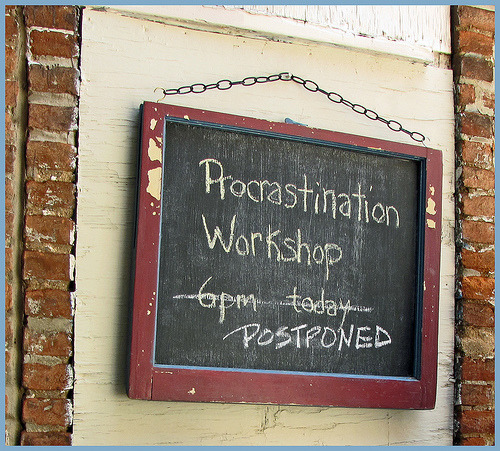It’s almost inconceivable that somebody as productive as Marc Andreessen, founder of Netscape, Opsware, Ning, and Andreessen Horowitz, needs a way to deal with procrastination. But it turns out he’s just like the majority of humankind.
His solution of structured procrastination is rather devious. Instead of fighting procrastination, go with the flow and put that task on hold. Meanwhile, work on something else. He explains:
The gist of Structured Procrastination is that you should never fight the tendency to procrastinate — instead, you should use it to your advantage in order to get other things done.
Generally in the course of a day, there is something you have to do that you are not doing because you are procrastinating.
While you’re procrastinating, just do lots of other stuff instead.

Photo: Dick Jensen
Andreessen actually learned this technique from reading an essay written by Stanford philosophy professor, Dr. John Perry, calling it “one of the single most profound moments of my entire life.” Perry explains in his wonderful piece how structured procrastination amazingly converts procrastinators so well that they end up being renowned for how much they get done.
In 1930, humorist and newspaper columnist, Robert Benchley, publicized the same idea in a very funny piece called “How to Get Things Done”, originally printed in the Chicago Tribune. Before he dives into a demonstration of this off-kilter method of getting things done, he spells out why structured procrastination works by getting at the heart of the habitual procrastinator:
The psychological principle is this: anyone can do any amount of work, provided it isn’t the work he is supposed to be doing at that moment.
This principle is why traditional methods of dealing with procrastination like pushing yourself harder or emptying your schedule just for the sake of focusing on that one task don’t reliably catch on. The method has certainly worked for me in the past, though I didn’t have a name for it.
I noticed I produce much more writing in total, and in less time, when I have multiple ideas and projects from which to choose than when I have just one.
Many people still don’t know Why people procrastinate in the afternoon and understanding that problem could be beneficial for their productivity.
The elegance of structured procrastination is twofold. One, it effectively squashes the worst thing about procrastination — the crushing guilt it generates. It’s as if your failure to produce work drives your psyche to produce something else instead — a dark, weighty force of guilt that, ironically, is great at sapping any motivation that’s left in the tank. Now, you can use that motivation to not do something to fuel getting something else done.
Second, it harnesses the second nature of the procrastinator to self-deceive. We already are skilled at taking some deadline for a task and stretching it out in our head. To get started on one specific task using structured procrastination, you just have to make sure there are a number of tasks on your list that sound important and assign something else the highest importance. Priority is in the eye of the procrastinator! Then, whatever is on the apparent back burner starts to look more appealing.
With structured procrastination, your motivation doesn’t have to suffer a crippling blow. The very habit that has been holding you back can actually move you forward. You’re procrastinating and productive at the same time — your output will be magically prodigious.
Liked this post? Subscribe to our free newsletter for more great content on productivity, management, and how to work better!
